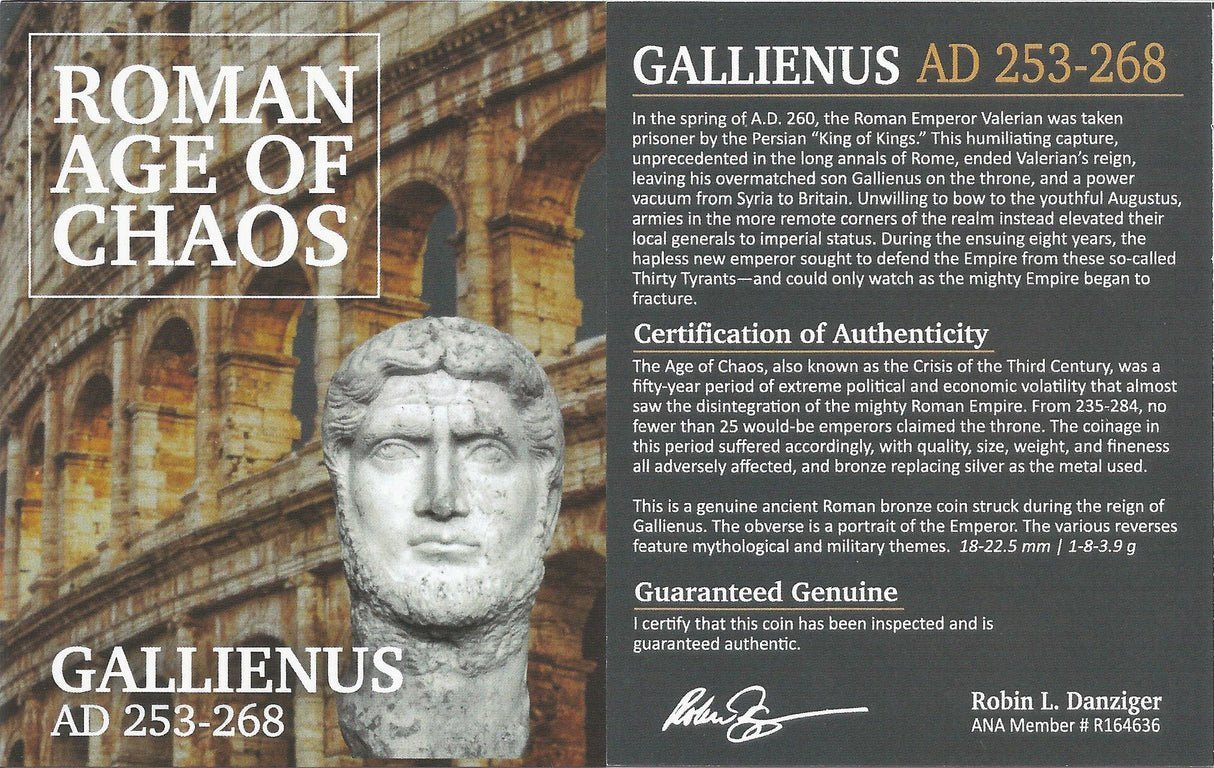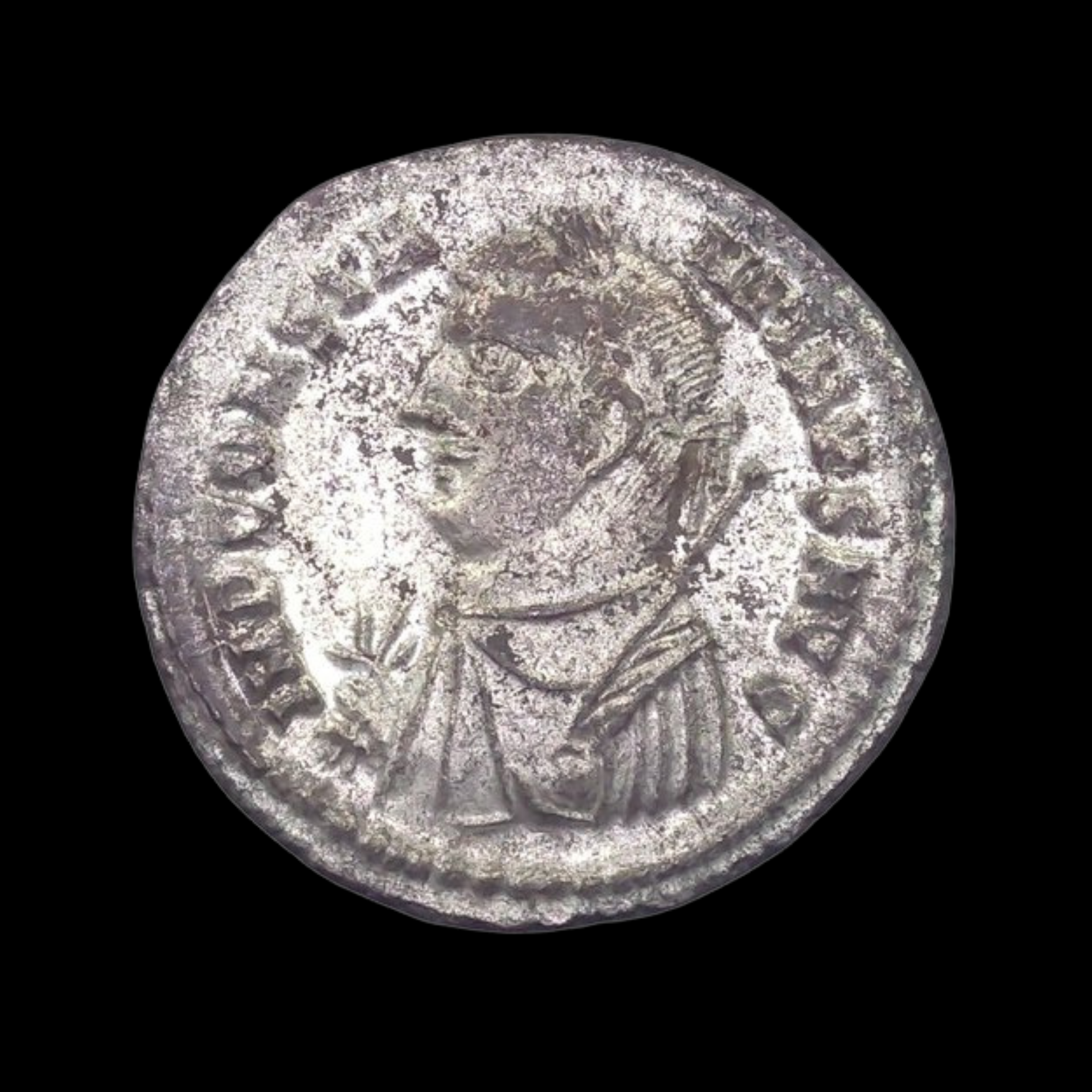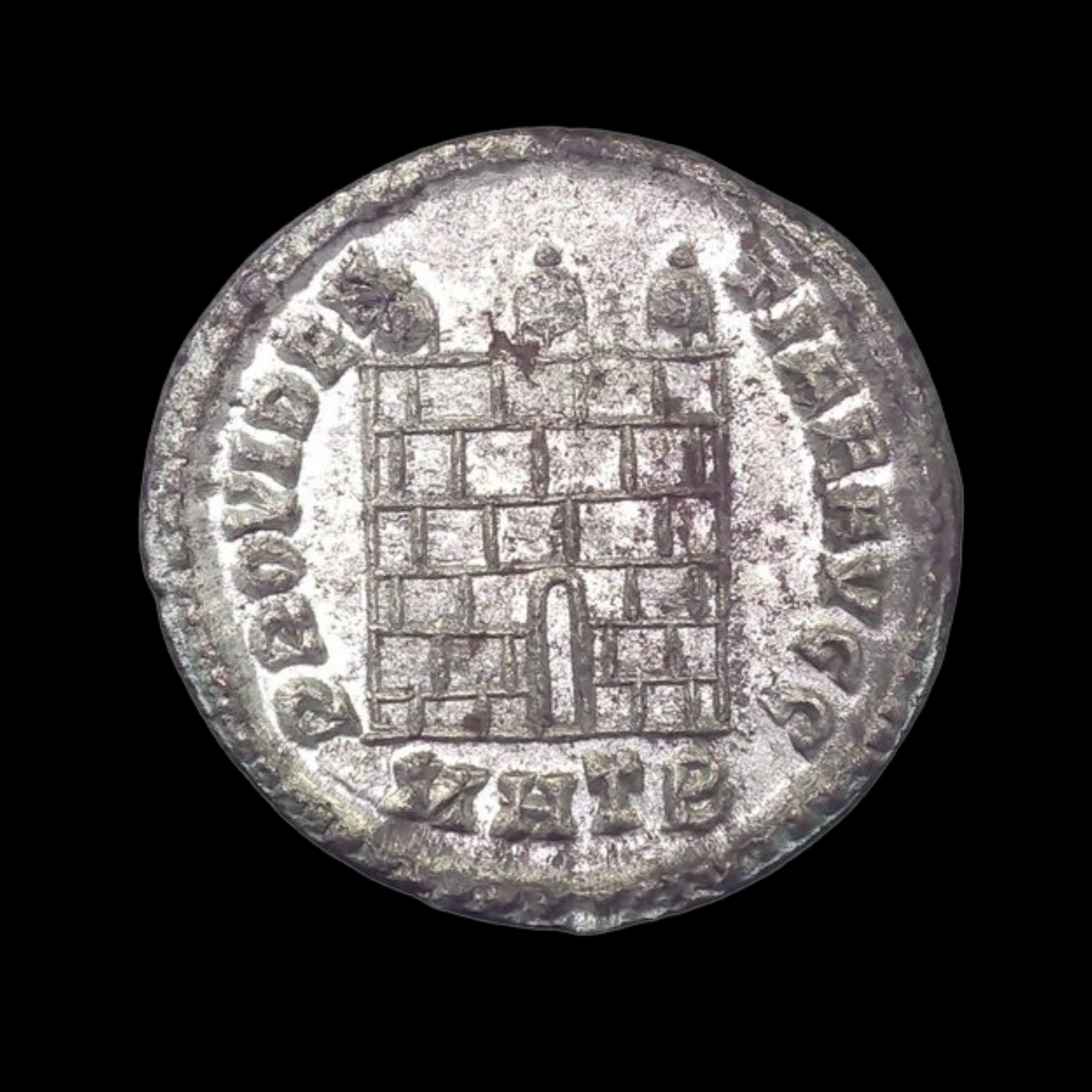 Image 1 of 8
Image 1 of 8

 Image 2 of 8
Image 2 of 8

 Image 3 of 8
Image 3 of 8

 Image 4 of 8
Image 4 of 8

 Image 5 of 8
Image 5 of 8

 Image 6 of 8
Image 6 of 8

 Image 7 of 8
Image 7 of 8

 Image 8 of 8
Image 8 of 8









Roman Bronze Coin of Emperor Gallienus (about 1,760-1,770 years ago)
This bronze coin was minted during the reign of Emperor Gallienus, who ruled the Roman Empire during a particularly tumultuous period known as the "Crisis of the Third Century." After his father Emperor Valerian was captured by the Persians in 260 AD, Gallienus was left to rule an empire facing numerous external threats and internal rebellions, yet he managed to maintain control for nearly 15 years during this chaotic era.
Coin Description:
Front side: Portrait of Emperor Gallienus wearing a radiate crown (a crown with rays resembling sun rays), facing right, with Latin inscription giving his name and titles
Back side: Likely depicts a Roman deity or personification (such as Victory, Peace, or Security) with accompanying Latin text expressing wishes for prosperity or military success
Technical Details:
Bronze composition (AE stands for "aes" meaning bronze in numismatic terminology)
Denomination: Antoninianus (a double denarius, worth two denarii)
NGC certified (Numismatic Guaranty Corporation, a professional coin grading service)
Minted between 253-268 AD
Condition dependent on specific example
Historical Significance: This coin circulated during one of Rome's most difficult periods when the empire faced multiple crises including barbarian invasions, military revolts, economic decline, and plague. When Gallienus' father Valerian was captured by Shapur I of Persia (modern Iran) in 260 AD—becoming the only Roman emperor ever taken prisoner by a foreign power—Gallienus was left to defend the fragmenting empire alone. Despite losing control of regions like Gaul (modern France) and Palmyra (in modern Syria), Gallienus implemented important military reforms and managed to preserve much of the empire until his assassination in 268 AD.
This bronze coin was minted during the reign of Emperor Gallienus, who ruled the Roman Empire during a particularly tumultuous period known as the "Crisis of the Third Century." After his father Emperor Valerian was captured by the Persians in 260 AD, Gallienus was left to rule an empire facing numerous external threats and internal rebellions, yet he managed to maintain control for nearly 15 years during this chaotic era.
Coin Description:
Front side: Portrait of Emperor Gallienus wearing a radiate crown (a crown with rays resembling sun rays), facing right, with Latin inscription giving his name and titles
Back side: Likely depicts a Roman deity or personification (such as Victory, Peace, or Security) with accompanying Latin text expressing wishes for prosperity or military success
Technical Details:
Bronze composition (AE stands for "aes" meaning bronze in numismatic terminology)
Denomination: Antoninianus (a double denarius, worth two denarii)
NGC certified (Numismatic Guaranty Corporation, a professional coin grading service)
Minted between 253-268 AD
Condition dependent on specific example
Historical Significance: This coin circulated during one of Rome's most difficult periods when the empire faced multiple crises including barbarian invasions, military revolts, economic decline, and plague. When Gallienus' father Valerian was captured by Shapur I of Persia (modern Iran) in 260 AD—becoming the only Roman emperor ever taken prisoner by a foreign power—Gallienus was left to defend the fragmenting empire alone. Despite losing control of regions like Gaul (modern France) and Palmyra (in modern Syria), Gallienus implemented important military reforms and managed to preserve much of the empire until his assassination in 268 AD.
This bronze coin was minted during the reign of Emperor Gallienus, who ruled the Roman Empire during a particularly tumultuous period known as the "Crisis of the Third Century." After his father Emperor Valerian was captured by the Persians in 260 AD, Gallienus was left to rule an empire facing numerous external threats and internal rebellions, yet he managed to maintain control for nearly 15 years during this chaotic era.
Coin Description:
Front side: Portrait of Emperor Gallienus wearing a radiate crown (a crown with rays resembling sun rays), facing right, with Latin inscription giving his name and titles
Back side: Likely depicts a Roman deity or personification (such as Victory, Peace, or Security) with accompanying Latin text expressing wishes for prosperity or military success
Technical Details:
Bronze composition (AE stands for "aes" meaning bronze in numismatic terminology)
Denomination: Antoninianus (a double denarius, worth two denarii)
NGC certified (Numismatic Guaranty Corporation, a professional coin grading service)
Minted between 253-268 AD
Condition dependent on specific example
Historical Significance: This coin circulated during one of Rome's most difficult periods when the empire faced multiple crises including barbarian invasions, military revolts, economic decline, and plague. When Gallienus' father Valerian was captured by Shapur I of Persia (modern Iran) in 260 AD—becoming the only Roman emperor ever taken prisoner by a foreign power—Gallienus was left to defend the fragmenting empire alone. Despite losing control of regions like Gaul (modern France) and Palmyra (in modern Syria), Gallienus implemented important military reforms and managed to preserve much of the empire until his assassination in 268 AD.
Publius Licinius Egnatius Gallienus (/ˌɡæliˈɛnəs/; c. 218 – September 268) was Roman emperor with his father Valerian from 253 to 260 and alone from 260 to 268. He ruled during the Crisis of the Third Century that nearly caused the collapse of the empire. He won numerous military victories against usurpers and Germanic tribes, but was unable to prevent the secession of important provinces. His 15-year reign was the longest in half a century.
Born into a wealthy and traditional senatorial family, Gallienus was the son of Valerian and Mariniana. Valerian became Emperor in September 253 and had the Roman Senate elevate Gallienus to the rank of Augustus. Valerian divided the empire between him and his son, with Valerian ruling the east and his son the west. Gallienus defeated the usurper Ingenuus in 258 and destroyed an Alemanni army at Mediolanum in 259.



















